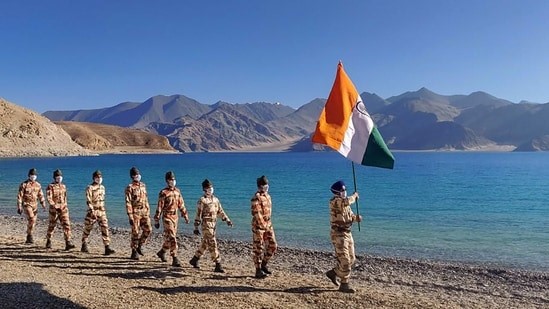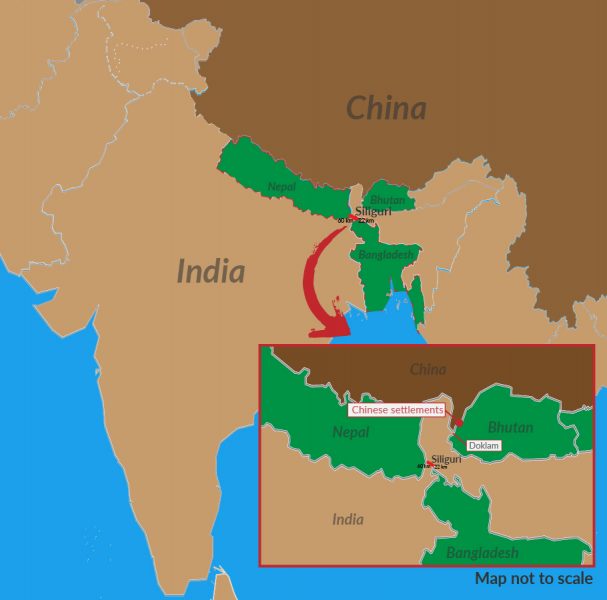
China changing rules of engagement with India on disputed border

Reports of China constructing a slew of settlements for troops, bridges and similar infrastructure across the Line of Actual Control (LAC) and across Bhutan have set the cat among the pigeons in India, with a section of the media raising an alarm over the unsettling developments.
The latest — the construction of military infrastructure and build-up of Chinese troops on the Himachal-China LAC, a bridge across a strategic lake in the Ladakh region and an array of buildings to the north of Bhutan — indicates that the Xi Jinping government in Beijing is unmindful of the nervousness it has triggered off in India. The proverbial ball is in India’s court in terms of how it plans to respond to the strategic, status quo altering, activity of its powerful neighbour.
Strangely, the Indian government so far has neither reacted with urgency nor appears to be unduly bothered by the actions of the Chinese. To an earlier instance when Beijing altered the names of 15 areas in Arunachal, an external affairs spokesperson had said merely changing names would not alter reality.
On the construction of a bridge across the Pangong Tso (Lake) an official spokesperson Arindam Bagchi downplayed reports of a possible transgression and said it had been built on the Chinese side of the LAC.
Also read: India has little idea how to handle Beijing’s belligerence
Defence Minister Rajnath Singh recently contended that India too has been active along the LAC and has built infrastructure – mainly roads and access points. But, it is widely acknowledged that this is nowhere near the level of construction by the Chinese.
India’s Army Chief General M M Naravane, on the occasion of Army Day, to a pointed question about the Chinese activities, reminded the media that the border between the two countries was unmarked.
He said the LAC was not demarcated which caused differing views. Until the boundary issue was resolved, such varying perceptions would continue, he said. If one were to interpret this, it simply means the entire 3500-km line between India and China is in reality no man’s land and either country can muscle its way into occupying it.

The LAC is fluid. On the ground, the two countries are expected not to transgress on areas that each other patrols. But this is frequently violated leading to clashes, the latest being the Galwan valley violence in June 2020 that caused the deaths of 20 Indian and at least five Chinese troops.
Naravane’s views, in some sense, encapsulate a larger truth — that of a simmering decades old border dispute that is now coming home to roost. The 1962 conflagration between the two countries should have ideally served as an alert to resolve the issue once and for all – give or take some territory. Unfortunately, the bad blood caused due to the conflict and the entwining of the dispute with the internal politics of the two countries have since made a resolution that much more complex and hence, difficult.
At the moment, it looks like it is in India’s interest to show resolve and come to an agreement with the Chinese. ASAP.
Take the latest Chinese moves. Few would disagree that the construction of infrastructure across the Line of Actual Control (LAC) is a troublesome development for India. Yet, the government is not able to pressurise China – either by calling out any illegality or claiming transgression, as for all practical purposes the constructions are on no-man’s land.
Also read: India harvests ties with Russia to take on Sino aggression
All that the Indian Ministry of External Affairs (MEA) has been able to say is that the government is watching the developments that have a bearing on India’s security. The MEA also reportedly said it was aware of Chinese infrastructure-building for the past several years. Clearly, it is only the outing of Chinese construction by high-end satellite imagery from Western remote sensing agencies that has forced New Delhi to come out with some reaction.
The satellite images have revealed fervent Chinese activity on the disputed border with Bhutan. New Delhi’s close ally, the tiny Himalayan kingdom, has faced an India-type border dispute with China for the last four decades stretching across a 500-km border. Even as talks have been going on, Beijing has gone ahead and built at least 200 structures, including two-storey buildings, in six locations on the disputed border, reported the news agency Reuters, quoting from a satellite image analysis.
The Bhutanese government has kept quiet over these developments for the last two years when the construction began. Apparently, the pace of building speeded up in 2021. A government spokesperson in the capital, Thimphu, reportedly refused to comment on the construction.
The situation across Bhutan is an indirect challenge to New Delhi as the defence requirements of the tiny Himalayan kingdom is taken care of by India. The construction makes the 37-year-old Bhutan-China border talks an exercise in futility as the ground situation is altered and makes the Chinese case stronger, placing it at a huge advantage in any future resolution. Already 24 rounds of negotiations have taken place with no end in sight. Analysts in fact say that the construction will force Bhutan to yield to Chinese claims.
The Chinese structures are incidentally coming up a few kilometres from Doklam (a junction bordering India, China and Bhutan) which was the site of a tense stand-off in 2017. At the time, after two months, the two countries had disengaged and withdrew from a position of confrontation.
Also read: India helped liberate Bangladesh. Why are we mute in face of Myanmar crisis?
For New Delhi, the coming up of infrastructure is worrying as it brings China close to the chicken neck —a 60-km-long and 22-km-wide piece of land in West Bengal’s Siliguri district that connects India’s north-east to the rest of the country. Bordering the south-east of this corridor is Bangladesh, on the western border is Nepal and to the north-east is Bhutan and China (Tibet) to the north. (Check the map)
A much-talked-about border, it is a strategic headache for New Delhi as theoretically China can cut off the corridor amputating the north-east from the rest of India. The security threat only existed on paper as in reality the area to the north of this corridor was largely uninhabited and Chinese physical presence was around 130 km away.
The recent building of Chinese settlements along the disputed border with Bhutan has the potential to alter the situation as it brings it within a hand-shake distance of India. Once the construction is complete and the Chinese military sets up shop there the threat rises sharply. In the event of a conflict, the chicken neck will expose India’s vulnerability manifold as the distance reduces sharply.
In 2017, China attempted to construct infrastructure in Doklam and met with stiff resistance from India and eventually both backed off. In hindsight, it now appears China simply changed its strategy. Beijing shifted construction towards Bhutan thereby insulating itself from any direct Indian response.
Though India takes care of Bhutanese defences, unless the government in Thimpu calls for military assistance, New Delhi cannot challenge China suo motu.
Four years later, Beijing’s strategy seems to have borne fruit with a full-fledged infrastructure across Bhutan that is bound to change the rules of engagement permanently between India and China.

